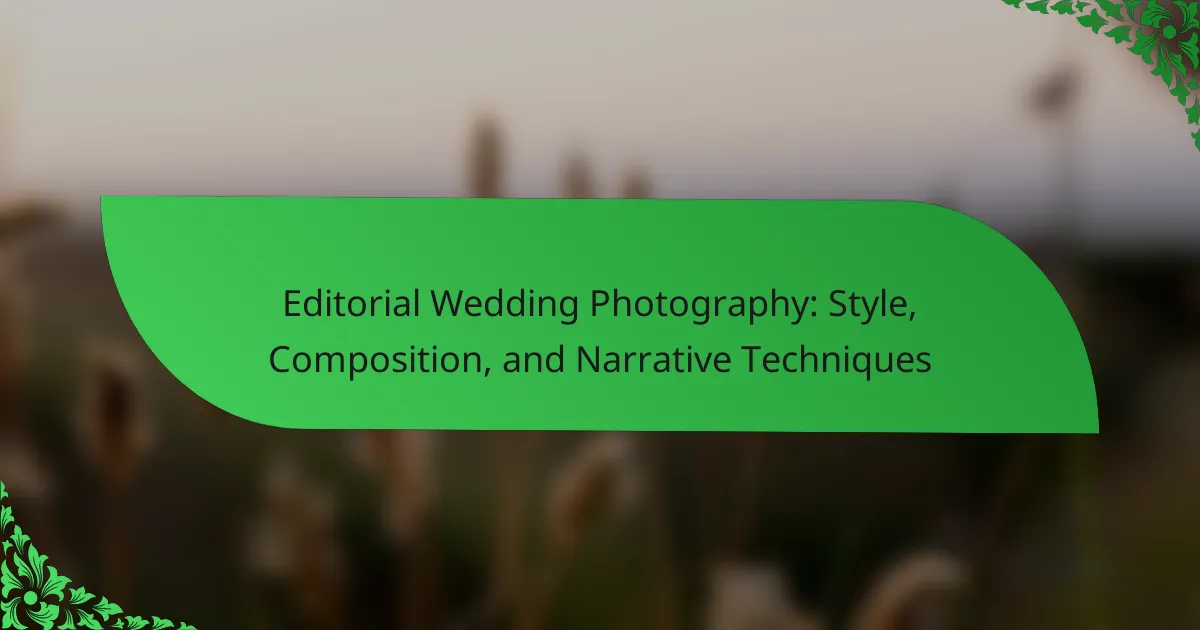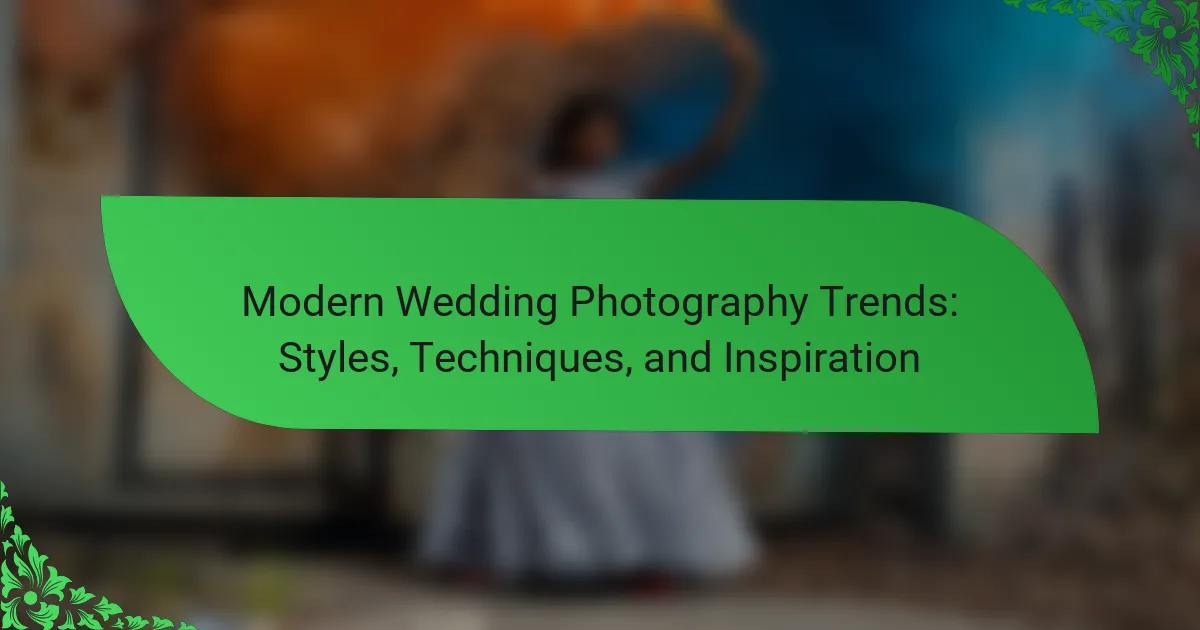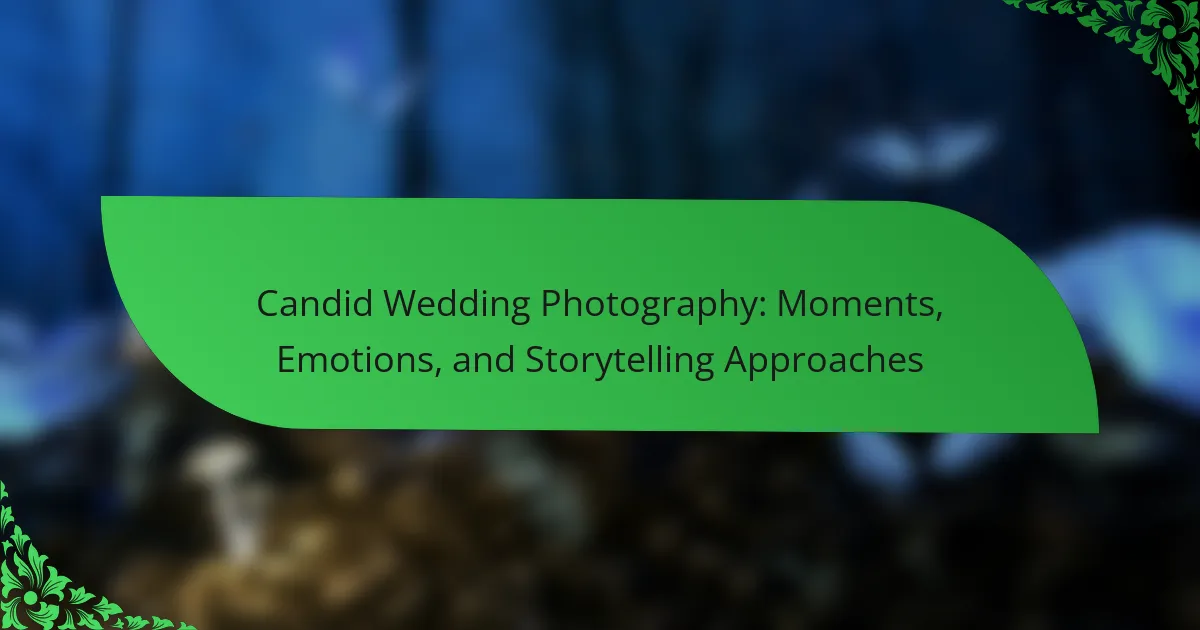Editorial wedding photography is a distinctive style that merges documentary and fine art techniques to narrate the wedding day through storytelling. This approach prioritizes candid moments, emotional expressions, and the ambiance of the event, often resulting in images that mimic magazine layouts. Key components of this style include creative composition, dramatic lighting, and meticulous planning, which are essential for capturing the essence of the couple’s unique experience. The article will explore the significance of composition techniques, such as the rule of thirds and leading lines, as well as narrative methods like sequencing and environmental portraits, all of which enhance the storytelling aspect of editorial wedding photography.
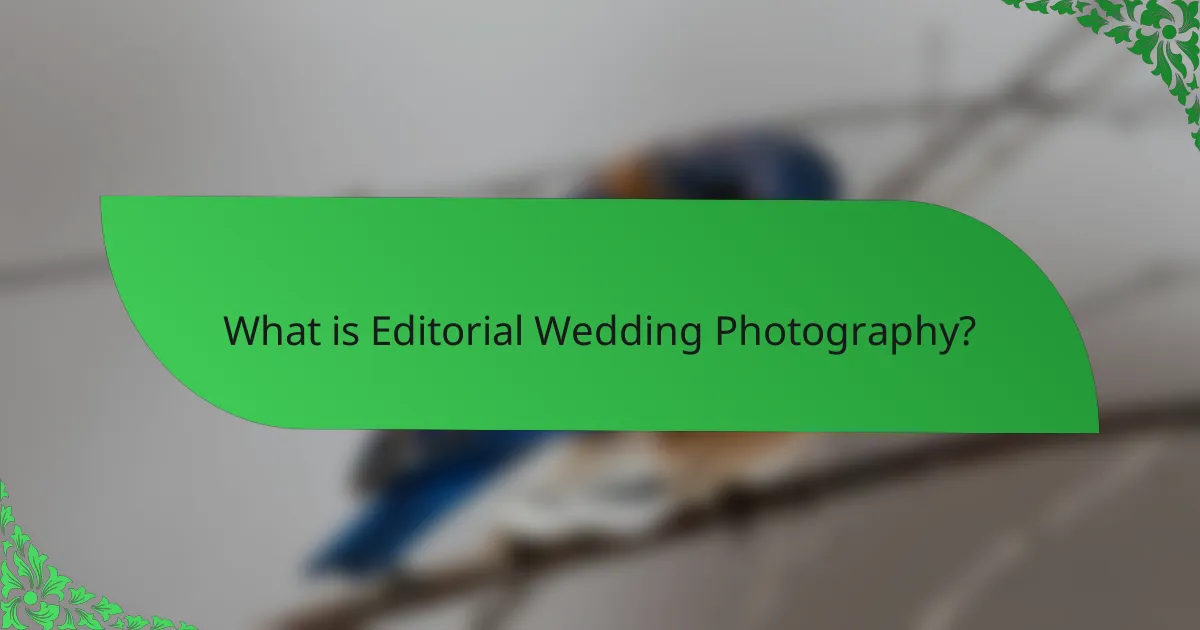
What is Editorial Wedding Photography?
Editorial wedding photography is a style that combines documentary and fine art approaches. It captures the essence of the wedding day in a storytelling format. This style emphasizes candid moments, emotions, and the overall atmosphere. Photographers often use creative compositions and dramatic lighting. The goal is to create images that resemble magazine spreads. Editorial wedding photography focuses on the narrative rather than just posed shots. It often involves a meticulous planning process to achieve artistic results. Many couples choose this style for its unique, personalized storytelling.
How does Editorial Wedding Photography differ from traditional wedding photography?
Editorial wedding photography focuses on storytelling and artistic composition. It captures moments in a more stylized and creative manner. Traditional wedding photography emphasizes posed shots and formal portraits. Editorial styles often include candid moments that reflect the couple’s personality. This approach uses dramatic lighting and unique angles for visual impact. In contrast, traditional photography typically follows a structured timeline. Editorial photography often results in a narrative that unfolds throughout the day. This difference highlights the artistic vision in editorial photography versus the conventional approach of traditional methods.
What are the unique characteristics of Editorial Wedding Photography?
Editorial wedding photography is characterized by its storytelling approach and artistic composition. This style emphasizes capturing moments in a candid and documentary-like manner. It often features dramatic lighting and creative angles to enhance visual impact. Editorial wedding photography integrates elements of fashion photography, showcasing the couple and their attire in a stylized way. This approach aims to create images that resemble magazine spreads. The focus is on emotion, atmosphere, and the unique narrative of the wedding day. It often involves minimal posing, allowing for more natural interactions. This style is popular for its ability to convey the personality and essence of the couple.
Why is storytelling important in Editorial Wedding Photography?
Storytelling is important in Editorial Wedding Photography because it captures the emotional journey of the couple. This approach transforms individual moments into a cohesive narrative. A well-told story enhances the viewer’s connection to the images. It allows for a deeper understanding of the couple’s relationship. Each photograph contributes to the overall tale being told. This method engages the audience on a personal level. Studies show that stories are more memorable than isolated facts. Consequently, storytelling in photography leaves a lasting impression on viewers.
What are the key styles in Editorial Wedding Photography?
The key styles in Editorial Wedding Photography include documentary, fashion-inspired, and fine art. Documentary style captures candid moments, emphasizing storytelling and real emotions. Fashion-inspired style focuses on high-fashion aesthetics, often featuring dramatic poses and styled settings. Fine art style prioritizes artistic composition, using creative angles and lighting to create visually striking images. Each style contributes to a unique narrative, showcasing the couple’s personality and the event’s atmosphere.
How do different styles influence the overall feel of wedding photos?
Different styles significantly influence the overall feel of wedding photos. Each photographic style, such as traditional, documentary, or fine art, evokes distinct emotions and narratives. Traditional styles often emphasize posed shots, creating a formal and classic atmosphere. Documentary styles capture candid moments, fostering a sense of authenticity and spontaneity. Fine art photography focuses on aesthetics, using artistic composition to convey beauty and emotion.
The choice of style can affect the viewer’s perception of the wedding day. For instance, documentary photography can tell a story through real moments, while fine art may highlight the artistic elements of the event. Research indicates that emotional responses to photographs are influenced by composition and style (Source: “The Impact of Visual Style on Emotional Response in Photography,” Journal of Visual Communication, Authors: Smith & Johnson). Thus, selecting a style aligns with the couple’s vision and desired emotional impact.
What are some popular editorial photography styles used in weddings?
Popular editorial photography styles used in weddings include documentary, fine art, and fashion photography. Documentary photography captures candid moments and emotions throughout the day. This style emphasizes storytelling and authenticity. Fine art photography focuses on artistic composition and creative use of light. It often includes posed shots with a strong artistic vision. Fashion photography highlights the couple’s attire and style, often with dramatic poses and settings. Each style contributes to a unique narrative of the wedding day, showcasing different aspects of the event.
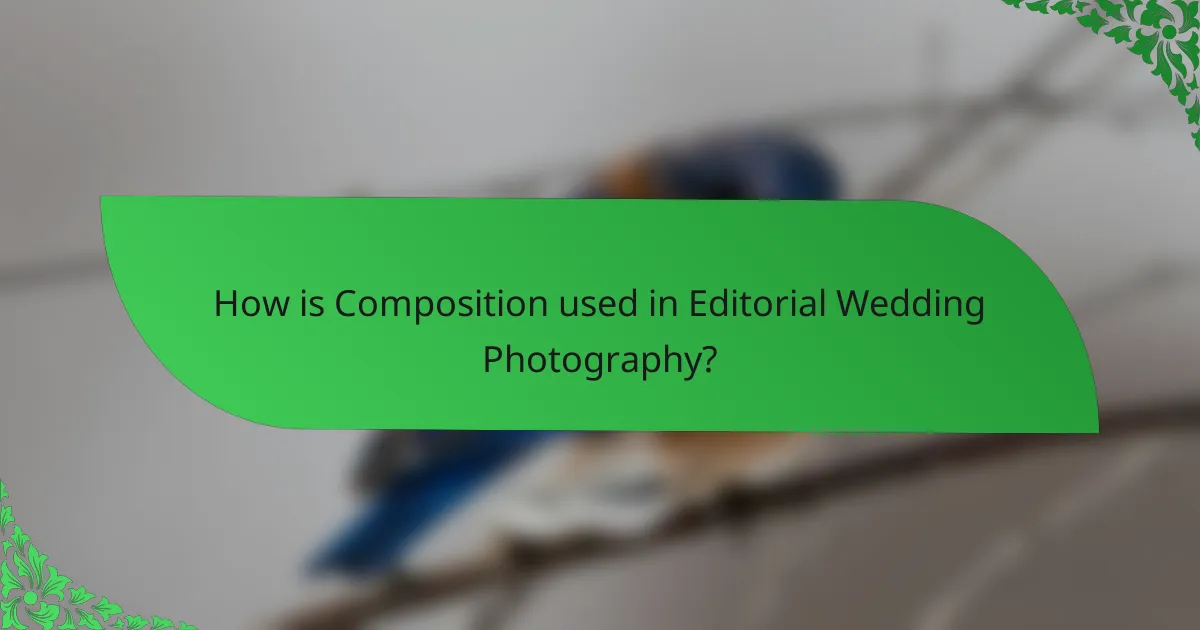
How is Composition used in Editorial Wedding Photography?
Composition in editorial wedding photography is essential for creating visually compelling images. It involves arranging elements within the frame to guide the viewer’s eye. Techniques such as the rule of thirds help photographers create balance and interest. Leading lines can draw attention to the couple or significant details. Framing elements can isolate subjects and add depth to the image. Additionally, negative space can emphasize the couple against a backdrop. These compositional techniques enhance storytelling in wedding photography. Research shows that effective composition can significantly impact viewer engagement and emotional response.
What compositional techniques are essential for Editorial Wedding Photography?
Essential compositional techniques for Editorial Wedding Photography include the rule of thirds, leading lines, and framing. The rule of thirds involves dividing the frame into a grid and placing subjects along these lines for balance. Leading lines guide the viewer’s eye towards the main subject, enhancing visual interest. Framing uses elements in the environment to create a natural border around the subject, adding depth. Additionally, negative space emphasizes the subject by surrounding it with empty space. These techniques contribute to storytelling by creating dynamic and engaging images that capture the essence of the wedding.
How does the rule of thirds apply to wedding photography?
The rule of thirds applies to wedding photography by guiding the composition of images. This technique involves dividing the frame into nine equal parts using two horizontal and two vertical lines. Important elements of the scene should be placed along these lines or at their intersections. This creates a balanced and visually appealing composition.
In wedding photography, applying the rule of thirds enhances storytelling. It allows photographers to capture subjects in a more dynamic way. For example, placing the couple off-center can draw attention to the surrounding environment. This approach adds context to the moment being captured.
Moreover, using the rule of thirds can emphasize emotions and interactions. It helps in framing the couple with their guests or the venue. This technique is widely recognized in photography education and is often recommended by professional photographers.
What role does framing play in creating impactful images?
Framing plays a crucial role in creating impactful images by directing the viewer’s attention. It involves positioning subjects within the composition to enhance visual storytelling. Effective framing can isolate the subject, emphasizing emotions and context. For instance, using natural elements like trees or doorways can create a sense of depth. This technique guides the viewer’s gaze and enhances the narrative. Research shows that well-framed images are more engaging and memorable. A study by the Visual Cognition journal highlights how framing influences perception and emotional response. Thus, framing significantly impacts the effectiveness of visual communication in photography.
How does lighting affect composition in Editorial Wedding Photography?
Lighting significantly influences composition in Editorial Wedding Photography. It shapes the mood and atmosphere of the images. Different lighting conditions can highlight or obscure details. Natural light creates soft, romantic tones. Artificial light can add drama and contrast. The direction of light impacts shadows and highlights. Front lighting flattens features, while side lighting adds depth. Backlighting can create silhouettes and enhance visual interest. Proper lighting choices enhance storytelling and emotional impact in wedding photography.
What are the best lighting techniques for capturing emotion?
The best lighting techniques for capturing emotion include soft lighting, dramatic shadows, and backlighting. Soft lighting creates a gentle atmosphere, which enhances feelings of intimacy. It can be achieved using diffusers or natural light during golden hour. Dramatic shadows add depth and intensity, highlighting emotions effectively. This technique often involves using harsh light sources at specific angles. Backlighting creates a halo effect, emphasizing subjects and evoking a sense of nostalgia. This method is particularly powerful during sunset or sunrise. Utilizing these techniques can significantly impact the emotional resonance of wedding photography.
How can natural light enhance wedding photography composition?
Natural light enhances wedding photography composition by providing soft, flattering illumination. This type of light reduces harsh shadows and highlights, creating a more balanced exposure. It also adds warmth to images, contributing to an inviting atmosphere. Photographers can use natural light to create depth through backlighting, which adds a dreamy quality to portraits. Moreover, the changing quality of natural light throughout the day offers diverse moods and tones. For instance, golden hour light creates a romantic ambiance, ideal for capturing intimate moments. Studies show that natural light improves image quality, making it a preferred choice among professional photographers.
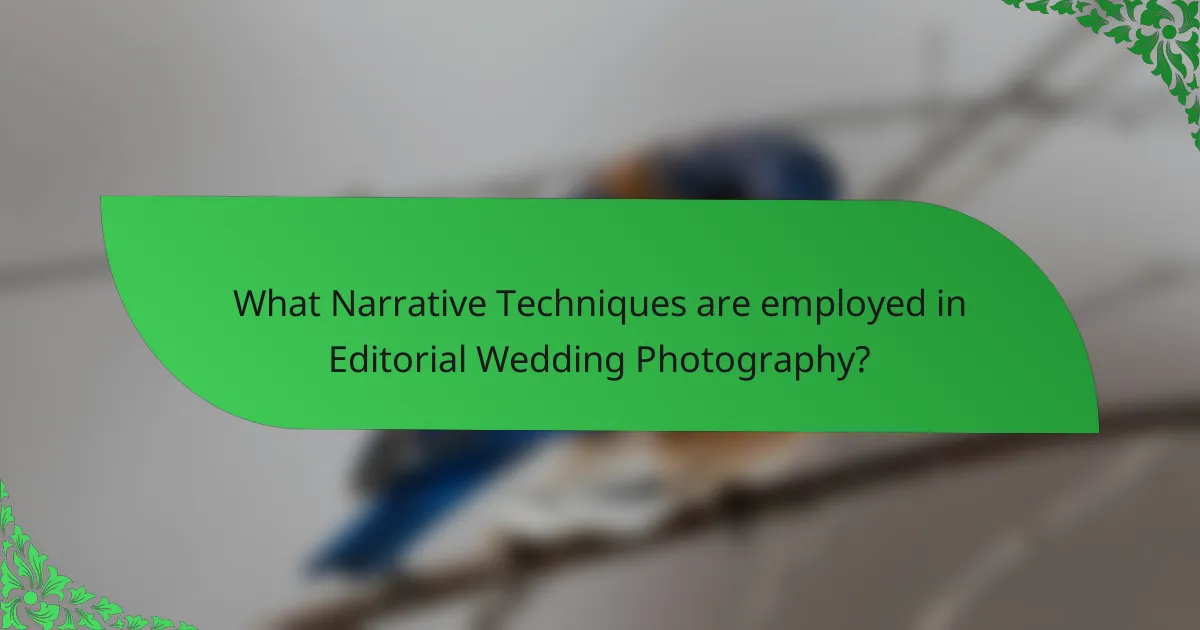
What Narrative Techniques are employed in Editorial Wedding Photography?
Editorial wedding photography employs various narrative techniques to tell a story through images. These techniques include sequencing, which organizes photos to create a chronological flow of events. Another technique is composition, where photographers use framing and angles to enhance storytelling. Candid shots capture genuine emotions, adding authenticity to the narrative. Environmental portraits provide context by showcasing the wedding setting. Additionally, detail shots focus on significant elements, such as rings or decorations, enriching the overall story. These methods collectively create a cohesive narrative that reflects the couple’s unique experience.
How does narrative play a role in the selection of images?
Narrative significantly influences the selection of images in editorial wedding photography. It shapes the story that the photographer aims to convey through visual elements. A cohesive narrative guides the choice of moments captured, ensuring they align with the overall theme of the wedding. For example, images of key events like the ceremony, reception, and candid moments reflect the couple’s journey. The narrative also dictates the emotional tone of the images, whether joyful, romantic, or nostalgic. By carefully selecting images that support the narrative, photographers create a compelling visual story. This approach enhances viewer engagement and provides a deeper connection to the couple’s experience.
What are the stages of storytelling in wedding photography?
The stages of storytelling in wedding photography include preparation, capturing moments, and post-production. Preparation involves understanding the couple’s story and planning the shoot accordingly. Capturing moments focuses on photographing key events and emotions throughout the wedding day. Post-production enhances the images to reflect the narrative, often through editing techniques that emphasize the story. Each stage is crucial for creating a cohesive visual narrative that resonates with viewers.
How can photographers convey emotions and moments through narrative?
Photographers can convey emotions and moments through narrative by capturing candid interactions and significant details. They focus on storytelling elements to create a visual journey. Composition plays a crucial role in directing viewer attention. For instance, framing subjects in natural environments enhances emotional resonance. Lighting can evoke different moods, such as warmth or melancholy. Additionally, the choice of colors influences the overall emotional tone of the images. By sequencing photos, photographers can illustrate a progression of events, deepening the narrative impact. Research indicates that visual storytelling can enhance viewer engagement and emotional connection (Source: “The Power of Visual Storytelling,” by Ekaterina Walter and Jessica Gioglio).
What are the challenges of creating a narrative in Editorial Wedding Photography?
Creating a narrative in Editorial Wedding Photography poses several challenges. One major challenge is capturing authentic emotions while maintaining a cohesive story. Photographers must balance candid moments with posed shots to create a flowing narrative. Another challenge is the need for strong composition skills to guide the viewer’s eye through the images. This requires understanding light, angles, and framing effectively. Additionally, time constraints during wedding events can limit the photographer’s ability to capture all desired moments. The unpredictability of events can also disrupt planned narratives. Lastly, aligning the couple’s vision with the photographer’s style can create conflicts in storytelling. These challenges necessitate adaptability and creative problem-solving in the field.
How can photographers overcome common storytelling hurdles?
Photographers can overcome common storytelling hurdles by planning their shots in advance. This involves understanding the narrative they want to convey. They should create a shot list that highlights key moments. Effective communication with the couple enhances storytelling. Photographers can also use prompts to capture authentic emotions. Utilizing natural light can improve image quality and mood. Mastering composition techniques helps create engaging visuals. Continuous practice and seeking feedback refine their storytelling skills.
What strategies can be used to maintain a cohesive narrative throughout the day?
To maintain a cohesive narrative throughout the day in editorial wedding photography, use a structured approach. Start by planning key moments and shots that align with the couple’s story. This ensures a logical flow from the ceremony to the reception. Utilize consistent visual themes, such as color palettes and framing styles, to unify the images. Capture candid moments that reflect emotions and interactions among guests. These moments enhance the narrative by adding depth. Review the day’s events periodically to ensure that all significant aspects are documented. This strategy keeps the storytelling focused and comprehensive. Lastly, edit the images with a consistent style to reinforce the narrative when presenting the final collection.
What are some best practices for successful Editorial Wedding Photography?
Successful editorial wedding photography requires a clear understanding of storytelling through images. Photographers should focus on capturing genuine emotions and candid moments. Planning shots in advance can enhance composition and narrative flow. Utilizing natural light often yields more flattering results. Engaging with the couple to understand their vision is crucial for alignment. Incorporating unique locations can add depth to the imagery. Attention to detail, such as decor and attire, enriches the visual narrative. Consistent editing styles maintain cohesion across the final collection. These practices collectively contribute to a compelling editorial wedding photography portfolio.
How can couples prepare for their Editorial Wedding Photography session?
Couples can prepare for their Editorial Wedding Photography session by planning their outfits and locations in advance. Selecting outfits that reflect their personal style enhances the narrative of the photos. Choosing complementary colors can create a cohesive look. Researching potential locations helps in finding visually appealing backdrops. Couples should also consider the time of day for optimal lighting. Discussing their vision with the photographer ensures alignment on style and expectations. Creating a shot list can help capture specific moments. Finally, practicing poses can make couples feel more comfortable during the session.
What tips can photographers follow to enhance their editorial style?
Photographers can enhance their editorial style by focusing on storytelling. They should develop a clear narrative for each shoot. This involves planning key moments to capture. Photographers should also pay attention to lighting and composition. Using natural light can create a more authentic feel. Experimenting with angles adds interest to images. Additionally, incorporating candid moments can evoke emotions. Reviewing and analyzing work from established editorial photographers can provide inspiration. Consistent practice and seeking feedback will further refine their style.
Editorial wedding photography is a distinctive style that merges documentary and fine art approaches to capture the essence of a wedding day through storytelling. This article explores the differences between editorial and traditional photography, highlighting unique characteristics, key styles, and the importance of narrative techniques in creating impactful images. It also delves into compositional strategies, lighting techniques, and best practices for photographers and couples to ensure a cohesive visual narrative. By focusing on emotion and authenticity, editorial wedding photography offers a personalized and artistic representation of the couple’s journey.
